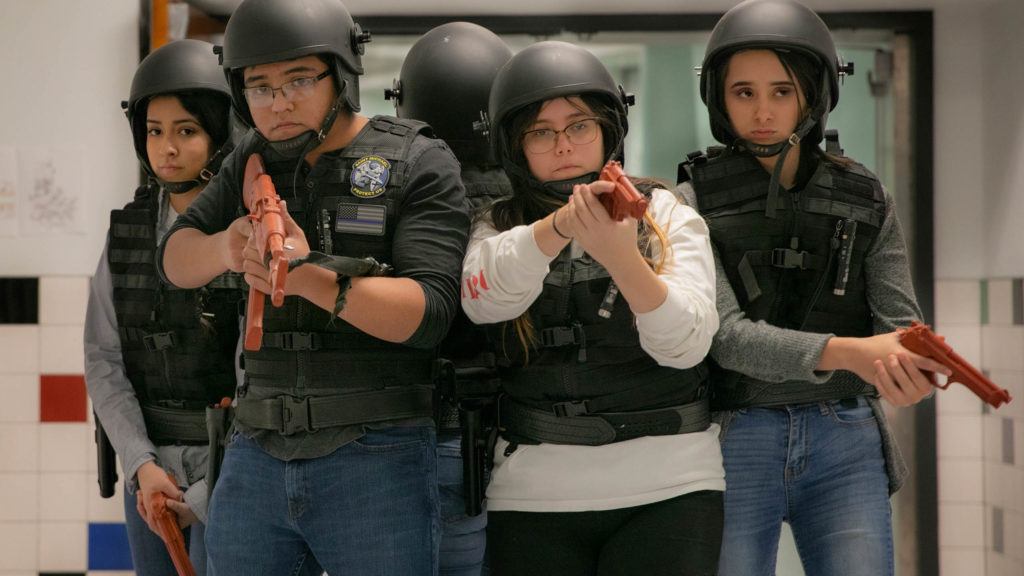At The Ready

AT THE READY, directed by Maisie Crow. Image courtesy Sundance Institute.
El Paso has the lowest crime rate of any city with a population in excess of 500,000. Despite that, as the opening insert notes, in 2018, more than 900 schools in Texas offered law enforcement education. Horizon High School, located less than thirteen miles from the U.S.-Mexico border, features a Criminal Justice Club sponsored by teachers who are all former Border Patrol agents.
The documentary, directed and produced by Maisie Crow, follows three students, Cesar, Cristina, and Mason (transitioned from Kassy just as the documentary was nearing completion). Cesar wants to go into law enforcement, perhaps to exorcize some of the anger he feels about his father getting involved in narcotics trafficking despite holding down a decent job. Cristina believes that the program helps the community, as she sees violence and drugs as forces pushing against stability. Mason, a latchkey kid whose father works all hours of the night, looks forward to the simulated drug busts. Each is drawn to the program for different reasons, but they all find community and friendship within the group. In this sense, the instructors play on teenagers’ needs for identity and validation.
Well-compiled and edited, Crow’s documentary presents us with the microcosms of high school and El Paso life. Gradually, as the scope pulls wider, we start to see the constant barrage of in-school and on-air propaganda. Unless and until they leave for college, the most attractive prospect for a decent paying job in the immediate area is Customs & Border Patrol.
Also quickly evident is the club’s focus on BORTAC-style raids, military tactics, and heavy emphasis on use of firearms. As Professor Timothy Dunn of Salisbury University, Maryland, notes in his peer-reviewed article, “The military’s deep involvement over nearly a decade has imbued the Border Patrol to at least some extent with militarism, perhaps in organizational culture, and in the framing of problems, objectives, and solutions.”¹
Regarding Border Patrol culture, one of the students notes the staff are decidedly pro-Trump. That they openly discuss political leanings in the Criminal Justice Club we can at first glance dismiss as an aspect of Southern life. Yet besides drug raid simulations, little to no teaching is actually done.
On closer examination, it’s more indoctrination than instruction. They’re talking about the border wall and not talking about the American demand for cheap migrant labor. teacher goes on about narcotics trafficking, despite the fact that narcotics busts account for less than seven percent of CBP’s total drug seizures in 2020¹. 760,000 of the 858,000 pounds seized were marijuana, which is now legal in 11 states. These teachers never actually teach enforcement, or de-escalation, or any aspects of the job. Instead, they play cops and robbers with rubber guns and spend the rest of the classroom time molding the young with this falsehood that most Border Patrol engagement is violent or involves narcotics seizures.
There’s zero discussion of immigration law or civics concepts such as due process and equal protection rights, which played a central role in numerous Supreme Court precedents—including Plyler v. Doe which struck down a Texas statute barring undocumented immigrants from receiving public education, a violation of the Fourteenth Amendment’s Equal Protection clause.
Some students reach their breaking point when reading stories and hearing sound recordings documenting the effects of Trump’s policy of family separation. One mother wonders why don’t they swiftly process and deport the children detained at Tornillo, though we know now the cruelty was the only point. Still, surprisingly only one student drops out of the program—the one who leaves town to attend college.
- Source: U.S. Customs and Border Protection – Drug Seizure Statistics.
- Dunn, Timothy. 1999. Military collaboration with the Border Patrol in the U.S.-Mexico border region: Inter-organizational relations and human rights implications. Journal of Political and Military Sociology, vol. 27 (Winter): 257-277. Indirectly taken from the Masters Thesis of Christopher Montoya, Arizona University.